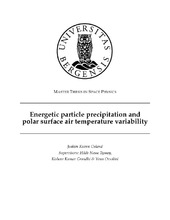| dc.description.abstract | Energetic Particle Precipitation (EPP) is known to have an impact on the chemical and thermal properties of the middle and upper atmosphere. Recent studies have also found ground level temperature anomalies in the polar regions in periods after high particle activity, with reductions in radiative cooling from ozone affecting the dynamics of the atmosphere. Using the geomagnetic Ap-index as a proxy for EPP, the AO-index as a proxy for polar regional temperatures as well as MERRA-2 reanalysis temperature data, these signatures were investigated by finding correlation between the Ap- and AO-indices, and by dividing the years into high and low geomagnetic activity. The temperatures of low activity years and total climatology of the MERRA-2 data were subtracted from the high activity years, showing the temperature anomalies associated with EPP. The atmospheric conditions of the Sudden Stratospheric Warmings (SSW) and the Quasi-Biennial Oscillation (QBO) were taken into account to ensure our data was not biased towards their impacts. This was done at ground level (1000 hPa), in the lower troposphere (850 hPa), the middle stratosphere (10 hPa) and at the stratopause (1 hPa), to determine if signatures found were similar to those expected by the direct effect and dynamic response found by previous studies. The stratopause levels (1 hPa, ~50 km) showed warm anomalies in-line with reduced radiative cooling from ozone, with cold anomalies in parts of the middle stratosphere (10 hPa, ~30 km) corresponding to a potential dynamic response. Ground level and lower troposphere showed warm anomalies above northern Europe and Siberia, with cold anomalies over North America and Greenland. This corresponds fairly well with the anomalies corresponding to positive AO-index, implying EPP may modulate the Arctic temperatures towards positive AO conditions, indicative of a strong polar vortex and reduced Brewer-Dobson circulation. | en_US |
